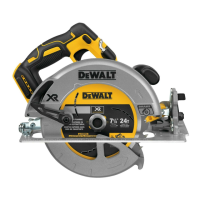15
ENGLISH
Adjusting
1. Slacken the fence adjustment knob
27
and set the parallel
fence
28
to the desired width. The adjustment can be read
on the parallel fencescale.
2. Tighten the fence adjustment knob
27
Mounting the Dust Extraction Port
(Fig.A, P)
Your circular saw is supplied with a dust extractionport.
To Install the Dust Extraction Port
1. Fully loosen depth adjustment lever
4
.
2. Place the base plate
5
in the lowestposition.
3. Align the left half of the dust extraction port
29
over upper
blade guard
7
as shown. Be sure to insert the tab into the
casting notch on the tool. When installed correctly, it will
snap fully over the original depth of cutpointer.
4. Align the right-hand piece
30
with theleft.
5. Insert screws and tightensecurely.
Prior to Operation
• Make sure the guards have been mounted correctly. The
saw blade guard must be in closedposition.
• Make sure the saw blade rotates in the direction of the
arrow on theblade.
• Do not use excessively worn sawblades.
OPERATION
Instructions for Use
WARNING: Always observe the safety instructions and
applicableregulations.
WARNING: To reduce the risk of serious personal
injury, turn tool off and disconnect battery pack
before making any adjustments or removing/
installing attachments or accessories. An accidental
start-up can causeinjury.
Proper Hand Position (Fig. J)
WARNING: To reduce the risk of serious personal injury,
ALWAYS use proper hand position asshown.
WARNING: To reduce the risk of serious personal
injury, ALWAYS hold securely in anticipation of a
suddenreaction.
Proper hand position requires one hand on the main handle
26
, with the other hand on the auxiliary handle
12
.
LED Worklight (Fig.A)
The LED worklight
15
is activated when the trigger switch is
depressed. When the trigger is released, the worklight will stay
illuminated for up to 20seconds.
NOTE: The worklight is for lighting the immediate work surface
and is not intended to be used as aflashlight.
Switching On and Off (Fig.B)
For safety reasons the trigger switch
2
of your tool is equipped
with a lock-off button
1
.
Press the lock-off button to unlock thetool.
To run the tool, press the trigger switch
2
. As soon as the
trigger switch is released, the lock-off switch is automatically
activated to prevent unintended starting of themachine.
NOTICE: Do not switch the tool ON or OFF when the saw
blade touches the workpiece or othermaterials.
Workpiece Support (Fig.J–M)
WARNING: To reduce the risk of serious personal
injury, support the work properly and hold the
saw firmly to prevent loss ofcontrol.
Figures J and K show proper sawing position. Figures L and M
show an unsafe condition. Hands should be kept away from
cutting area, and power cord is positioned clear of the cutting
area so that it will not get caught or hung up on thework.
To avoid kickback, ALWAYS support board or panel NEAR the
cut, (Fig. J and K). DON’T support board or panel away from the
cut (Fig.L and M). When operating the saw, keep the cord away
from the cutting area and prevent it from becoming hung up on
the workpiece.
ALWAYS DISCONNECT SAW BEFORE MAKING ANY ADJUST-
MENTS! Place the work with its “good” side—the one on which
appearance is most important—down. The saw cuts upward,
so any splintering will be on the work face that is up when you
sawit.
Cutting (Fig. J)
WARNING: Never attempt to use this tool by resting it
upside down on a work surface and bringing the material
to the tool. Always securely clamp the workpiece and
bring the tool to the workpiece, securely holding the tool
with two hands as shown in FigureJ.
Place the wider portion of the saw base plate on that part of
the work piece which is solidly supported, not on the section
that will fall off when the cut is made. As examples, FigureJ
illustrates the RIGHT way to cut off the end of a board. Always
clamp work. Don’t try to hold short pieces by hand! Remember
to support cantilevered and overhanging material. Use caution
when sawing material frombelow.
Be sure saw is up to full speed before blade contacts material
to be cut. Starting saw with blade against material to be cut
or pushed forward into kerf can result in kickback. Push the
saw forward at a speed which allows the blade to cut without
laboring. Hardness and toughness can vary even in the same
piece of material, and knotty or damp sections can put a heavy
load on the saw. When this happens, push the saw more slowly,
but hard enough to keep working without much decrease
in speed. Forcing the saw can cause rough cuts, inaccuracy,
kickback, and over-heating of the motor. Should your cut begin
to go off the line, don’t try to force it back on. Release the switch
and allow blade to come to a complete stop. Then you can
withdraw the saw, sight anew, and start a new cut slightly inside
the wrong one. In any event, withdraw the saw if you must shift

